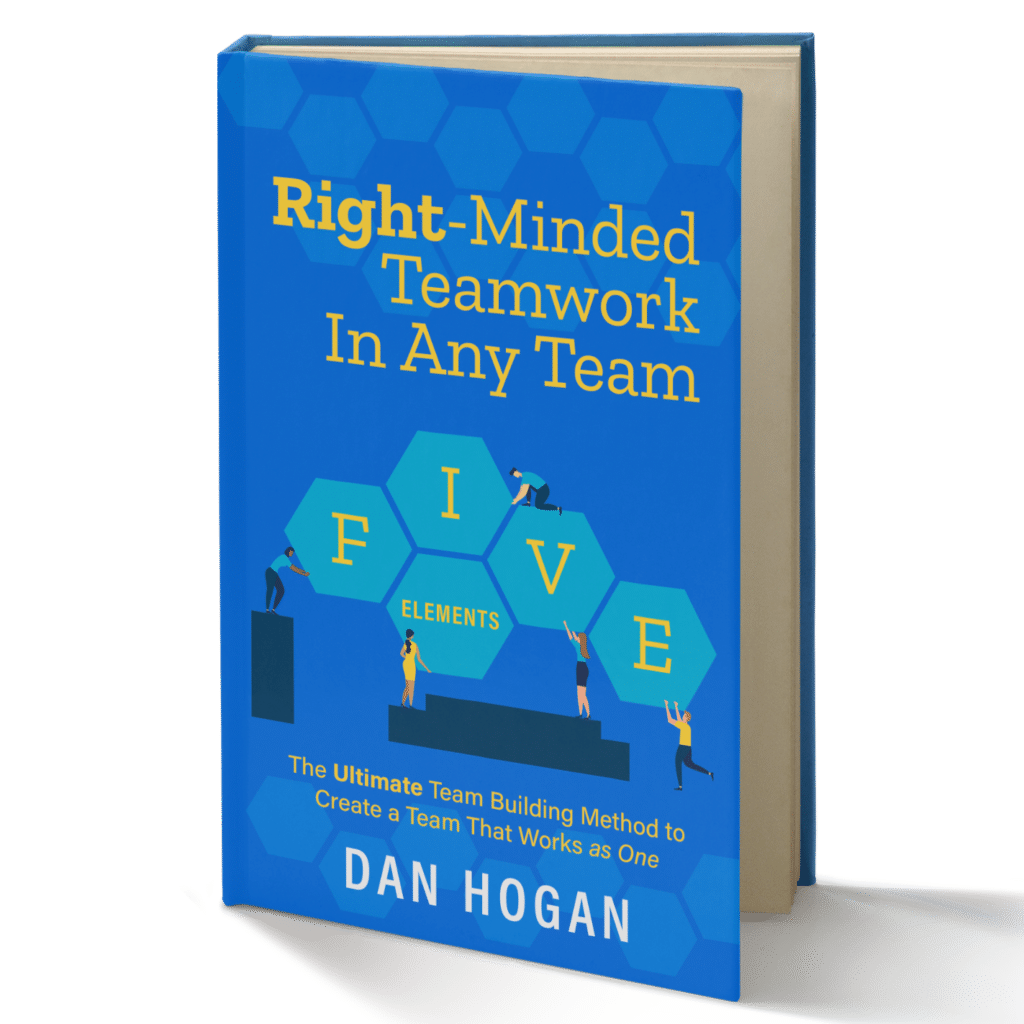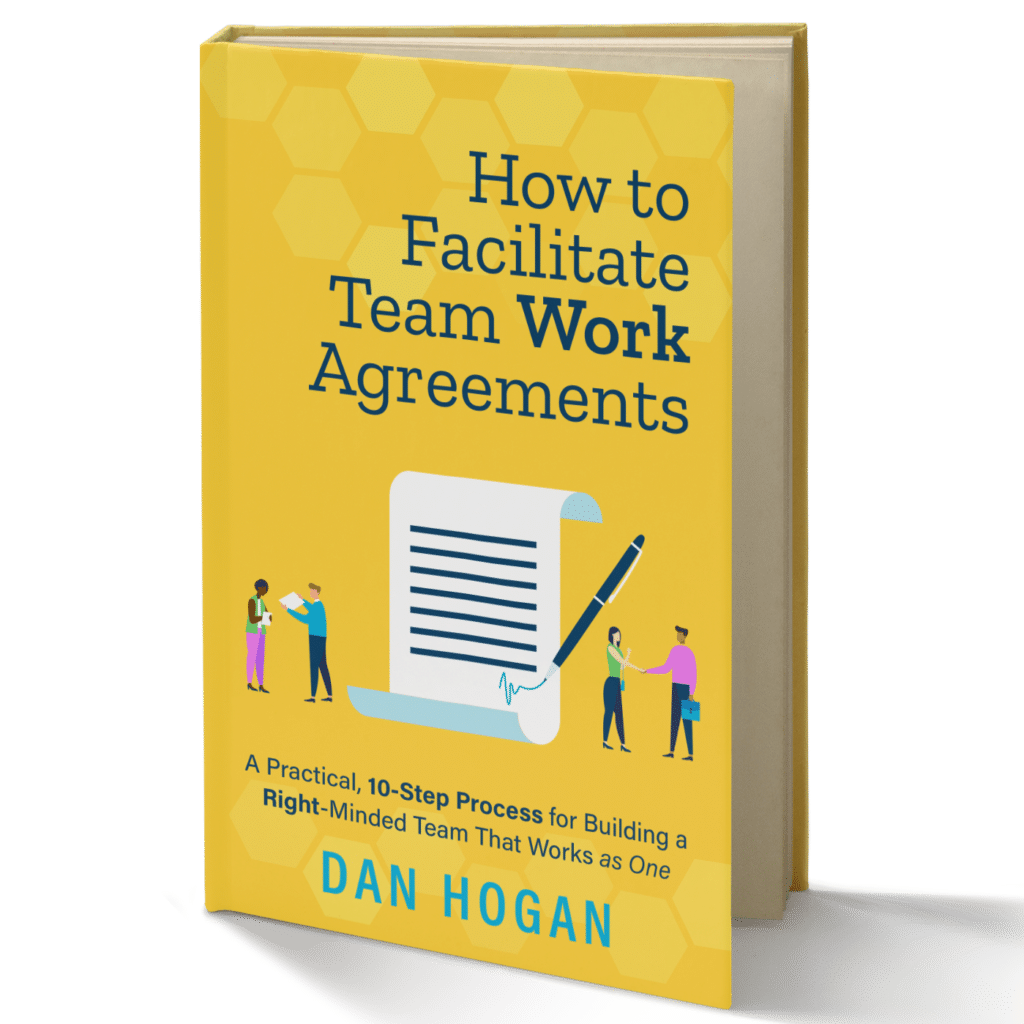Become an Effective Team Building Facilitator
There are many team-building facilitators. Not all are effective.
This article will present 1) three effective facilitator traits, 2) the best team-building method and 3) RMT’s 12-step process for designing a real-world team-building workshop.
Table of Contents
- The art and the science of team facilitation
- Three effective facilitator traits
- The range of team-building approaches, from worst to best [hint: real-world is best]
- The 12 steps to design a Right-Minded Teamwork team-building workshop [described in detail in our book]
- Your Next Steps
Team Building Facilitation: Both Art & Science.
Effective team-building facilitators understand that the “art of facilitation” is the ability to interact well with teammates. In other words, team facilitators lead by example, and there is an art to doing so.
When you personally exhibit Right-Minded attitudes and behaviors in front of teammates, you, by example, teach others emotionally mature teamwork behavior.
Moreover, you show them exactly how to work and behave as a high-functioning, Right-Minded teammate.
If not…
If you display egotistical or arrogant behavior, it will inevitably anger teammates. Moreover, it creates teammate resistance. Not leading by example, harms the team-building effort.
Therefore, the best facilitators always keep improving their own interaction and communication skills. They know doing so helps them succeed and serve their teams better.
The “science of facilitation” is your knowledge of the best teamwork methods.
For instance, you understand how teams operate. Further, you know how to approach problems strategically. And, you thoroughly see the value of guiding teams through a continuous improvement process, like the 5 Elements of Right-Minded Teamwork.
But science is not just knowledge. It is also the methodology in action.
The “science-in-action” is your ability to successfully apply Right-Minded Teamwork’s 12 Steps to design a real-world, customized, practical, team-building workshop.
When you combine both the art and science of team building facilitation, you successfully design and facilitate a workshop that produces powerful and tangible results.
Three Traits for Succeeding as a Team Building Facilitator
Effective team facilitators are skilled in three specific traits.
- Designing Workshops
- Facilitating Workshops
- Teaching in Workshops
In our book, we thoroughly present how to succeed in the first facilitator trait: – designing team-building workshops.
Here we will present an overview of the 12 Step Design Process. This approach creates what we will define as a real-world, team-building workshop.
The other two facilitator traits – (facilitating in the workshop and teaching), are also essential, but we will discuss them in other articles and training classes.
Before we discuss the workshop design process, let’s talk about what is and is not real-world team building.
Ranges of Team-Building Options: From Worst to Best
Team building sounds simple. How can so many people still have it wrong?
Here is a list of the worst team-building exercises as well as some good team activities.
Team Building Exercises: Worst of the Worst
In Alison Green’s article, 10 Horrifying Team Building Exercises, you can read about some foolish and irrational activities that are called “team building.”
Please discourage others from thinking these activities are worthwhile team-building exercises. They are not.
Team Building Activities: A Little Better
Some well-meaning people believe happy hours, bowling, or similar activities serve as “team building.”
These are nice social events, and they can certainly encourage camaraderie. But please, do not call them team building. They, too, are not.
Team Building Play: Hit or Miss
In “experiential play” scenarios, teammates typically go to an outdoor playground-type facility. Together, they experience either low-element games (played on the ground) or high-element exercises (constructed on poles).
In these settings, the teacher is accountable for providing a successful experience.
Ideally, participants gain new understandings from their time together that will benefit them and the team. In reality, though, while some team members may enjoy the experience, many do not.
Other team activities, such as games, can be fun. But just like outdoor play, activities like the Egg Drop game are not true team building, and results are limited.
Team Building Training: Can Be Helpful
Educational and training events can be helpful for teams. In this team-building approach, teammates attend some kind of lecture.
For example, an instructor might teach guidelines for resolving work process problems using the Six Sigma method. Or they might teach one of the personality type style indicators, like DiSC.
Once again, the instructor is responsible for creating a successful training experience.
The hope is that participants will use their newly learned guidelines to build better teamwork. Sometimes this works, and sometimes it does not.
Best of the Best: Real-World Team Building
Instead of yet another group bonding activity, teammates attend a custom Right-Minded team-building workshop.
This workshop is designed specifically to meet the team’s real-world needs could apply the RMTs 9 Right Choices for Building a Team That Works as One, or they could apply the 5 Elements of Right-Minded Teamwork.
No matter what real-world method you apply, designing a workshop based on RMT’s 12-Step process guarantees an effective team event, complete with real-world results that produce actual team-building growth.
In this workshop, team members discuss and resolve their real teamwork challenges. All exercises and discussions result in practical Work Agreements.
These Agreements outline how teammates will collaboratively work together to achieve their team’s business goals while respecting shared psychological values.
With Right-Minded Teamwork, teammates and the workshop facilitator are jointly held accountable for a successful team-building experience.
Instead of the team leader or facilitator merely hoping teammates will use their new knowledge on the job, teammates make firm, collective commitments to follow their new Work AgreementsA Work Agreement is a collective teammate promise to transform non-productive, adversarial behavior into collaborative teamwork behavior. More to improve their teamwork.
Real progress is made together. That is Right-Minded Teamwork.
12 Steps to Design a Right-Minded, Team-Building Workshop
Your client wants help. You know their needs.
How can you ensure you deliver a truly transformational workshop experience?
Read on, or Watch the Introductory Lesson below [~14 minutes] for FREE.
The 12 Step How to Design a Right-Minded Team Building Workshop book and training course will teach you how to design practical powerful team-building workshops.
If you want to be an effective team-building facilitator, use this process.
The 12 Steps are grouped into three continuous phases:
Contract: Designing the Workshop
Step 1:
The team leader determines the initial workshop’s purpose. Often workshops focus on something the team needs to change or improve because teammates are not working well together.
Step 2:
The team leader connects with the team-building facilitator. The leader conveys the purpose and potential outcomes for the workshop. Both agree to follow Right-Minded Teamwork’s 12 Steps Process.
Step 3:
The leader gives the facilitator permission to think of their initial desired outcomes as symptoms. This allows the facilitator to uncover root causes the leader may not have considered. In this step, it is not unusual to learn what the leader wants may not be what the team actually needs.
Step 4:
The facilitator creates and presents a 1st Draft Plan to the leader. The plan includes the initial set of workshop outcomes, an agenda, a Punch List of workshop topics, and an announcement plan.
Step 5:
The leader announces the workshop and prepares teammates. Teammates learn they will be interviewed by the facilitator. By offering their input and perspective, they will participate in designing the workshop outcomes and agenda.
Step 6:
The facilitator conducts a Right-Minded teammate survey to help identify potential workshop outcomes.
Step 7:
The facilitator interviews all teammates, summarizing their collective views in the Punch List document.
Step 8:
The facilitator creates and presents a 2nd Draft Plan to the leader.
Step 9:
The leader and facilitator fine-tune and agree on the final outcomes and workshop agenda. Together, they distribute the agenda and begin preparing teammates for the workshop.
Commence: Facilitating the Workshop
Step 10:
The leader and facilitator conduct the workshop and achieve workshop outcomes.
Teammates agree to track their performance after the workshop. They agree on what they will track, how they will track it, and to whom they will report their progress.
Carry On: Keeping Up Momentum
Step 11:
For the next 90 days, the team tracks their progress.
Step 12:
The leader and facilitator either begin designing the second workshop or decide to transfer that responsibility to others.
If the facilitator is asked to design the next workshop, the cycle continues onward, beginning with Step 1 again.
As the cycle is repeated over time, the team grows and evolves together into another Right-Minded Team That Works Together As One.
Your Next Steps
You have two learning options: 1) buy our ebook PACKAGE or 2) buy the paperback book.
The ebook PACKAGE here at Right-Minded Teamwork includes
- a comprehensive online video training course [the Free Introduction Lesson is above]
- with customizable reusable resources both PDF & Word documents [these are ONLY available here at the Right-Minded Teamwork website]
- the ebook [PDF & EPub] Design a Right-Minded Team-Building Workshop: 12 Steps to Create a Team That Works as One.
Buy the paperback book at Amazon or Barnes & Noble.
Either option will teach you the process and ensure you design a successful Right-Minded Team-Building Workshop.

Dan Hogan, Certified Master Facilitator
PS. I used this process for 30 years and it worked every time!











